Barbells are synonymous with weightlifting. If you work out at a commercial gym, you probably have noticed different types of barbells at your training facility.
Different types of barbells vary in shape and size and might feature different amounts of knurling (gripping lines on the metal), whip (the way the weight changes as the bar moves), and sleeves (the ends of the barbell that hold the weight plates).
As someone once said, “The best time to learn about different types of barbells was 10 years ago. The next best time is now.” Okay, no one said that, but someone should have.
It is time for more lifters to learn about the versatile training equipment. Using the right barbell can be the difference between hitting a personal best and getting injured.
Unless you are prepping for a strength sport meet, you should use a specialized barbell in your training for most lifts instead of the standard bar. The specialized bars can also come in handy if you’re dealing with injuries.
Also, if you want to stroke your ego with a bar-bending lift, you can do it without having to slap on gargantuan weights on the standard barbell. Read on to learn how.
-
18 Different Types of Barbells
- 1. Standard Barbell
- 2. Olympic Weightlifting Barbell
- 3. Deadlift Barbell
- 4. Powerlifting Barbell
- 5. Fixed Bar
- 6. EZ-Bar
- 7. Trap Bar / Hex Bar
- 8. Swiss Bar
- 9. Safety Bar
- 10. Cambered Bar
- 11. Duffalo Bar
- 12. Kabuki Transformer Bar
- 13. Freak Bar
- 14. Tsunami Bar
- 15. Bamboo Bar
- 16. Log Bar
- 17. Axle Bar
- 18. Elephant Bar
- Wrapping Up
18 Different Types of Barbells
Here are the barbells you should know about:
1. Standard Barbell
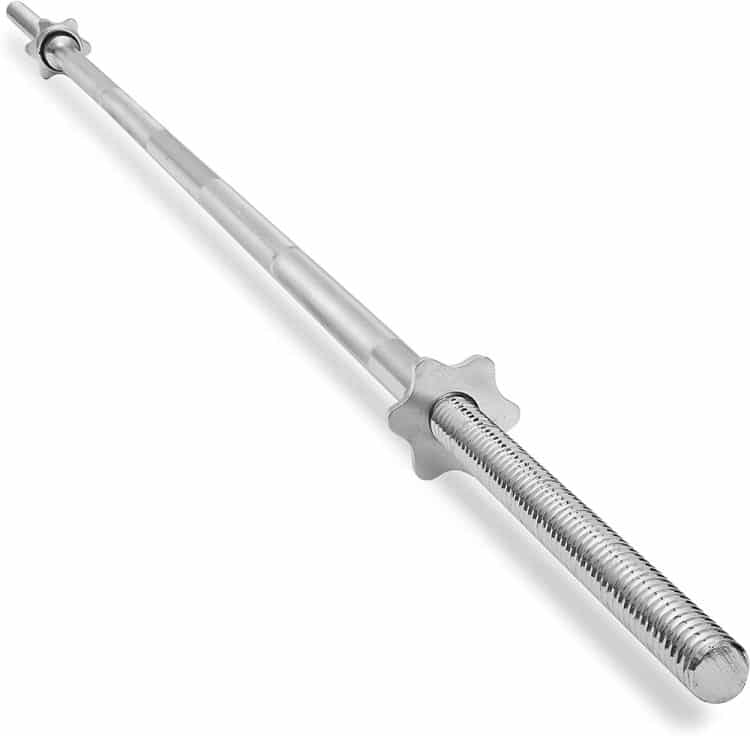
The standard barbell is the most common type of barbell, and you might find it on the squat rack and the bench press station in almost every gym around the world. It is generally seven feet and two inches long and weighs either 20 kilograms (44 pounds) or 45 pounds exactly.
The standard bar is generally very rigid and doesn’t bend unless extremely weighed down. The knurling on these bars can vary depending on the brand of the barbell, while the whip and sleeves usually remain standard.
2. Olympic Weightlifting Barbell

An Olympic barbell is a straight bar that weighs between 15 to 20 kilograms (33-44 pounds). Although they look similar to the standard barbell, they have a few distinctive features.
First — during a lift, the bar sleeves spin to assist with the movement. This can be a game-changer in powerlifting movements like the snatch, and clean and jerk. Additionally, the Olympic barbells have a little more whip than the standard bars, which can help with the explosive Olympic lifting movements by enhancing performance and reducing the risk of injury.
The knurling on Olympics bars is usually smoother than other bars as these barbells are generally used for quick movements, and too much engraving can be painful on the hands.
3. Deadlift Barbell
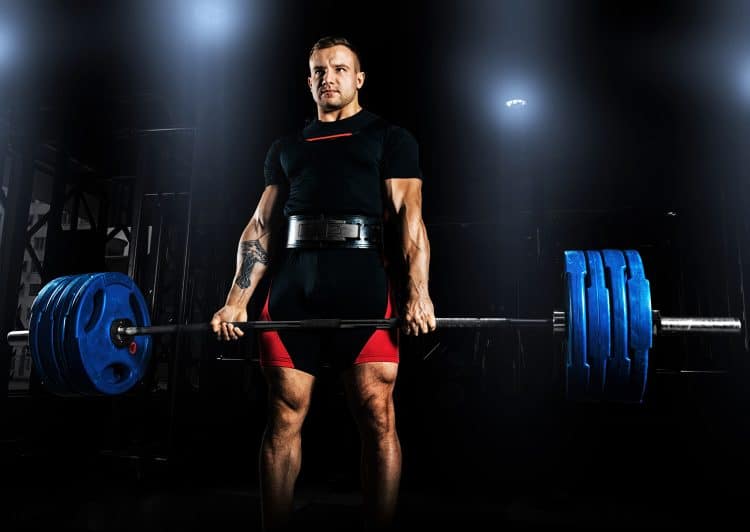
Deadlift bars tend to have more whip, making them more suitable for quick lifts up off the floor. They also have deeper knurling to improve a lifter’s grip. Finally, these barbells have a thinner and longer handle than Olympic bars. The thinner structure creates a higher amount of flex (bend) in the bar on the concentric phase of the lift.
The higher whip puts your hands in a slightly higher position than the weight plates while the bar is still on the floor. It makes the lift a little easier as the flex lets you extend your knees and hips while the bar is still on the ground, effectively shortening your range of motion.
4. Powerlifting Barbell
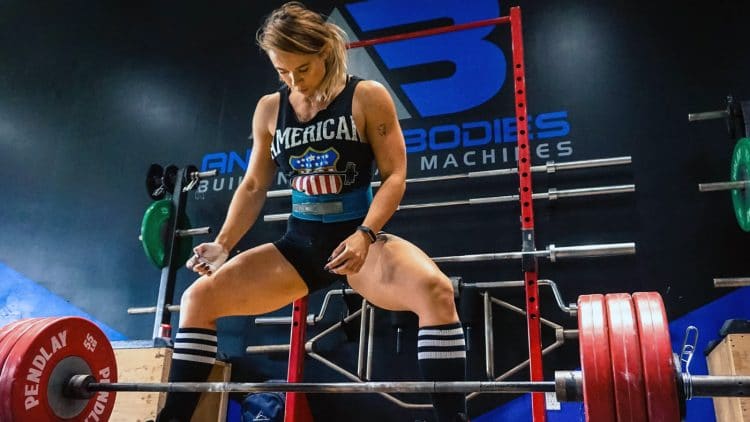
Powerlifting bars are similar to Olympic bars in that they are straight with thick ends. While Olympic bars have a slight whip as it helps the lifters perform the movements, powerlifting bars are rigid and have no flex to them. Powerlifting bars are built keeping in mind the monster weights used in powerlifting meets.
Grip marks are the other notable difference between powerlifting and Olympic bars. Grip marks on Olympic barbells are used as placeholders. On the other hand, grip lines on a powerlifting bar are used to maintain legal hand positions in competitions.
5. Fixed Bar
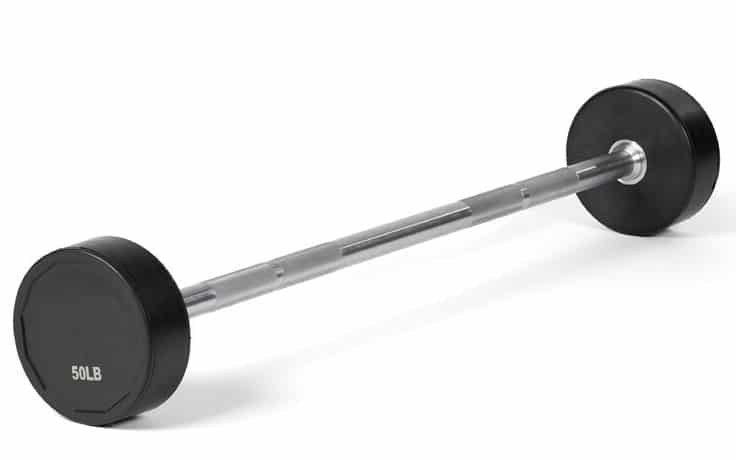
Unlike all the other barbells on the list, fixed bars don’t have loadable sleeves — meaning you cannot slide weight plates onto this type of bar. Fixed bars are pre-loaded and make your workouts more convenient by eliminating the need to change the weight on the bar after every set.
Read also: Barbell Weights: Learn How Much Barbells Weigh
6. EZ-Bar
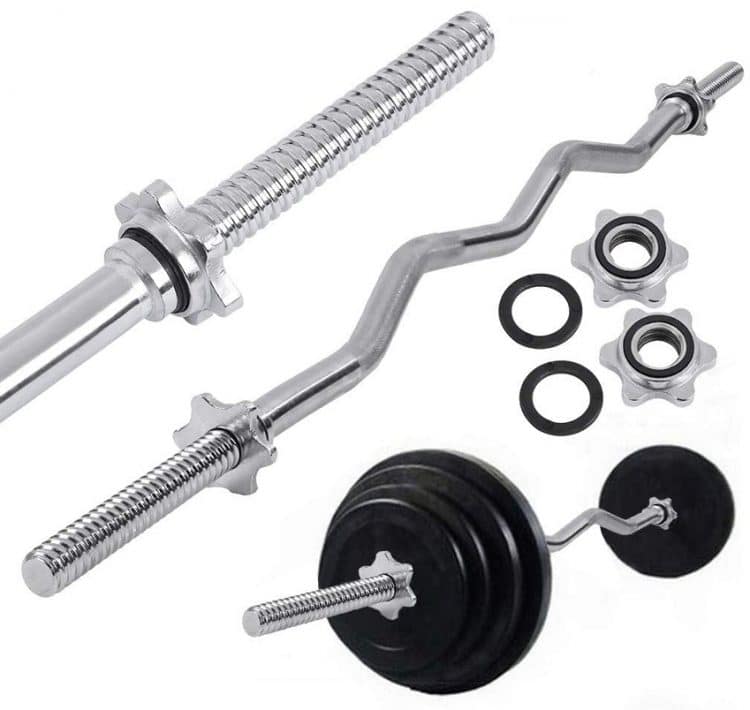
The EZ or curl bar is a cambered bar that helps alleviate stress from your wrists while performing the barbell bicep curl or tricep extension. It is a great bicep training bar alternative for limited wrist mobility.
The EZ-bar is generally used for training your biceps and triceps. They are usually four feet long, weigh 15 pounds, and come in fixed and loadable versions.
7. Trap Bar / Hex Bar
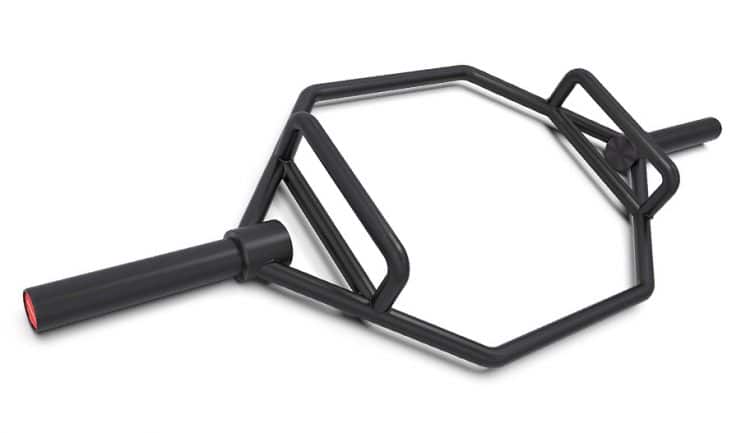
The trap bar is a four-sided barbell that is shaped like a trapezoid. It has knurled parallel handles and is a great standard bar alternative for performing compound exercises like the deadlift.
While performing the deadlift on a hex bar, you stand between the weight plates. The bar forces you to lower your butt instead of bending forward while performing the deadlift, putting comparatively little pressure on your lower back than the conventional barbell.
The hex bar also helps target your upper traps while performing the deadlift. It can also help you lift heavier as you are holding the barbell with a relatively comfortable neutral grip (palms facing each other).
Additionally, the trap bar is less stressful on your joints and allows a better grip. Trap bars weigh between 30 to 70 pounds and are generally used for deadlifts and farmer’s carry.
Related: Trap Bar Vs. Barbell Deadlift – Which One Should You Do?
8. Swiss Bar
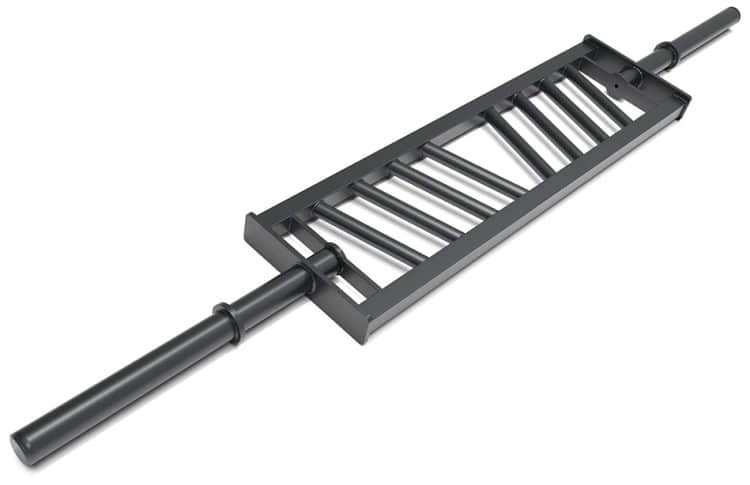
A Swiss bar gives you a plethora of gripping options. The neutral gripping options (palms facing in) while using the bar can be incredibly efficient for individuals with limited shoulder or upper-body mobility.
Also known as the multi-grip bar, neutral grip bar, or football bar, the Swiss bar provides the most variations in grip position of any standard loadable barbell. You could use the football bar for exercises like the bench press, bent-over row, overhead press, bicep curl, and overhead tricep extension. The Swiss bar comes with knurled grips that help you keep a firm hold of the bar while lifting.
9. Safety Bar
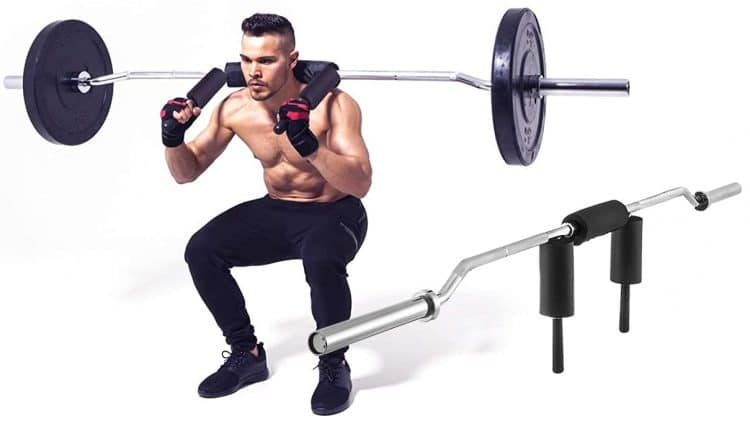
A safety bar is designed to make the squat more comfortable. If you are dealing with restricted shoulder mobility or have a tight upper back or wrists, a safety bar can help alleviate the stress from these joints.
Safety bars have handles attached to the shaft, allowing you to hold the barbell in front of your body with a more neutral grip. They also have leather or cloth padding — depending on the brand — for your neck and traps.
The safety bar, also known as a yoke bar, sits a bit higher on your back, making it a little easier to maintain an upright torso while squatting.
10. Cambered Bar
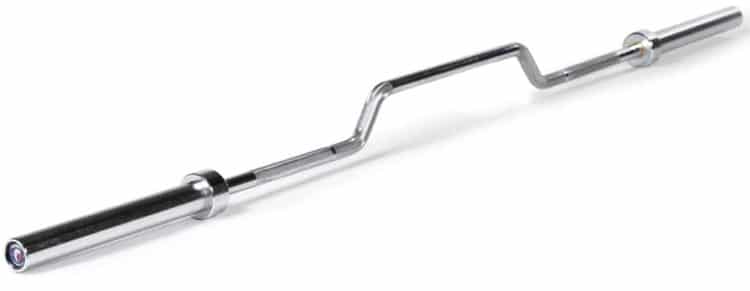
A cambered bar, also known as an arched bar, is one of the funkiest barbells on the different types of barbells list. While the bar rests on your shoulders, the actual weight (weight plates) sits much lower, near your sides. Using the cambered bar helps focus on your hamstrings and lower back.
The unique design of the arched bar makes it easier to keep an upright torso while achieving depth on the squat, resulting in greater muscle fiber recruitment.
Since the weight plates are at your waist level, the cambered bar squat results in core stabilizer activation. The depth of the cambered bar sidebars varies depending on the manufacturing company. The arch changes the mechanics of your squats and puts a greater load on your posterior chain.
Additionally, since the bar allows for lifters to hold onto the side handles, the bar is a great option for people dealing with shoulder pain.
11. Duffalo Bar
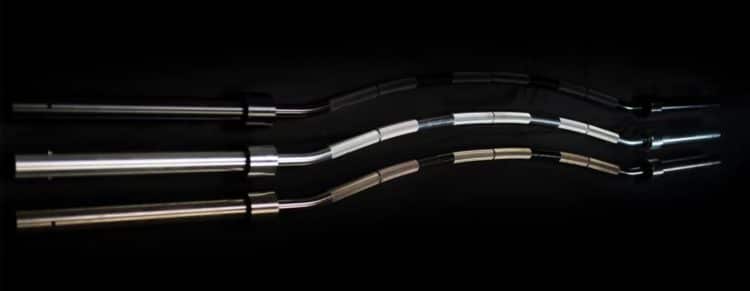
The Duffalo bar is developed by Kabuki Strength and powerlifter Chris Duffin. The specialized bar is curved across its shaft, which allows the lifter to utilize a greater range of motion on the bench press as your arms go deeper behind your torso before the bar touches your chest.
Additionally, the curved design of the Duffalo bar provides a more comfortable grip for a lifter on the squat, which is especially great for lifters that struggle to wrangle a low-bar position due to tight shoulders or wrists. It is said to reduce stress on the back, shoulders, and biceps during squats and pressing movements.
12. Kabuki Transformer Bar
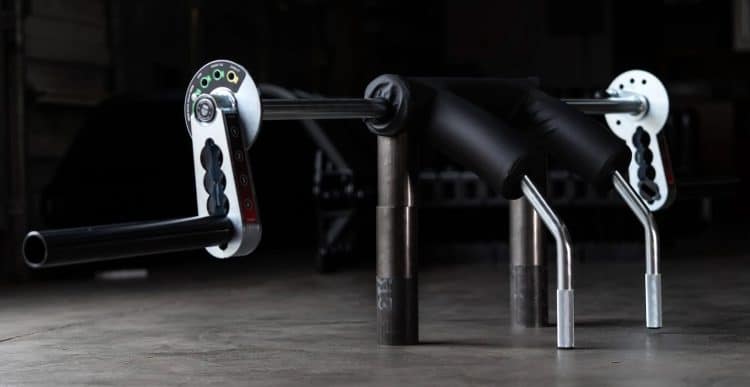
The transformer bar is another ground-breaking barbell developed by Kabuki. The specialized bar offers 24 different adjustments which help target specific muscles.
Like the safety bar, the Kabuki transformer bar comes with a shoulder and trap pad and has handles attached to the shaft, making it easier to hold while squatting. You probably won’t find a transformer bar in many gyms, but if you do, make sure you take it for a spin.
13. Freak Bar
The Freak bar is a patent-pending, plate-loaded bar developed by the late legendary powerlifter and coach Louie Simmons. Although the bar looks like a regular barbell, it is anything but that.
The Freak bar uses springs to allow grip adjustment throughout a lift. The constantly changing grip position helps strengthen your upper body and builds core stability. Per Westside Barbell, the specialized bar is great for correcting a bilateral deficit and putting muscle mass on the upper body.
14. Tsunami Bar
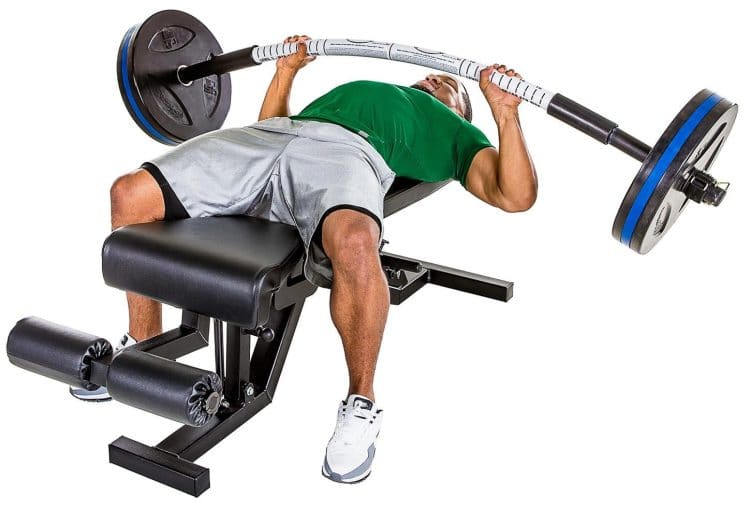
The Tsunami bar is the mirror opposite of a powerlifting barbell. While the latter is rigid, the former is highly flexible and bendy. The Tsunami bar comes in multiple levels of flexibility, weights, and grips and is designed to jolt and jiggle, even when using comparatively lightweight.
If your goal is to build upper body stability and control, you should add the Tsunami bar to your training regimen, given you have access to one at your gym. According to Tsunami Barbell, the creators of the Tsunami bar, the specialized training equipment helps improve an athlete’s strength and power by providing a unique overload stimulus to muscles, especially at sticking points.
15. Bamboo Bar

The Bamboo bar is designed to help improve a lifter’s ability to maintain bar stability. Unlike other barbells on the list, the flexible bar is made from bamboo.
While some bamboo bars might feature standard barbell sleeves for stacking weight plates, others have collars with slits in them for bands. In the case of the slits, weights dangle from the bands.
16. Log Bar

We are entering the strongman territory with this bar. You are more likely to find specialized equipment like the log bar in strongman gyms. The log bar is a variation of the straight bar with a metal cylinder around the shaft. It features a neutral grip that helps limit stress on the shoulders for all pressing movements.
The log bar is highly specialized training equipment and is best left to people who know what they are doing. Strongman JF Caron suffered a career-altering injury at the 2022 Arnold Classic USA in the log lift event.
Related: 2022 Arnold Strongman Classic Final Results – Martins Licis Is The Winner
17. Axle Bar

The axle bar is probably the thickest barbell used in strength sports. It can be up to two inches in diameter, making it incredibly hard to grip. This standard barbell alternative is generally seen in Strongman training and competitions.
18. Elephant Bar

The elephant bar is probably the rarest barbell on the different types of barbells list. The specialized barbell was created by Rogue Fitness for the Arnold Classic Strongman and debuted at the 2016 edition of the show.
It has an elongated shaft compared to the traditional barbell and is loaded with thicker and larger plates, making the bar extremely flexible. Like the deadlift bar, the whip of the elephant bar gives the lifters leverage by making it easier to extend their knees and hips by artificially shortening the range of motion.
Next Read: Barbells vs. Dumbbells: Which is Best?
Wrapping Up
If you have made it till here, you now probably realize that you are leaving gains on the table by staying in a monogamous relationship with the standard barbell.
By using different types of barbells in your training regimen, you’ll add variety to your workouts, make them more exciting, and shock your muscles into growing.


